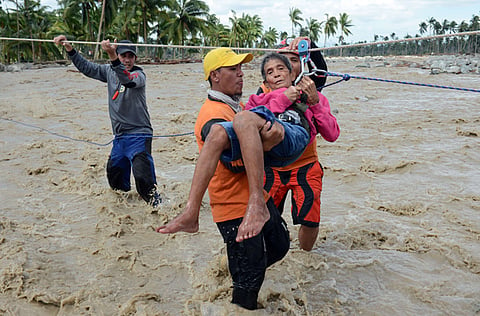Typhoon Bopha creates ‘horror river’
New river formed when Bopha flooded Philippine village with 45,000 residents

Manila: The death toll from typhoon Bopha rose to 647 and the number of missing people also rose to 817 on Sunday amid worry that the typhoon has created a "horror river" in its wake after sweeping through southern Philippines last week.
Illegal logging, mining, and settling on hazard prone areas were blamed for the high number of fatalities in the southern Philippines where typhoon Bopha also created a very wide and baffling “horror-river” in New Bataan, one of the hardest hit areas in Compostela Valley, one of the typhoon’s path, a local paper said.
The creation of the new river began when typhoon Bopha flooded Andap, a mountainous village with 45,000 residents whose homes were swept away by floods on December 4, after Bopha’s landfall on Mindanao’s northeastern part.
As this happened, Calyawan River became swollen, its water stripped the river bank’s topsoil and exposed large rocks (from the river bed). Inland, banana trunks bent northwest as they followed the typhoon’s torrential path that eventually split everything into pieces.
Mutilated bodies, mudslides, debris, and floods from Andap Village rolled down to the lower ground, creating a new river because the debris could not be emptied. It became a sorry sight of large rocks, tree trunks, debris, and dead bodies that were hidden underneath.
The mixture of debris from Andap village, the litters from the swollen Calyawan River, resulted in a new river that remained waist deep on the lower ground on December 7.
The sight was “surprising and horrifying”, coconut and banana grower Genovevo Valencia told the Inquirer.
“It is a river of horrors,” Feliciano and Alejandra Medrano also told the Inquirer, adding, “That river brought the dead from Andap village to our village [in Purok 8]. There is no name for that river yet,” Sebastian Mandantes, from nearby Camanlangan village said.
The new river has begun flowing into one of the many tributaries of Agusan River to the north.
True, the new river has obliterated plantations of coconut trees and settlers homes. It has remained a challenging place for volunteers who could only smell dead bodies but could not unearth the pile of dirt that has accumulated since the typhoon came on December 4.
It is not known if it will become a permanent river. The new topography that baffled people but could truly direct scientists about ancient water routes that should be avoided by settlers in Compostela Valley.
On Sunday, the number of affected population exceeded over five million. Of this, 131,000 people were still housed in 172 evacuation centres.
Of the 817 missing, over 500 were from Compostela Valley and Davao Oriental which was ravaged by flashfloods and strong winds, according to the National Disaster risk reduction and Management Council.
Since last year, typhoons have been meandering dangerously on Mindanao, the country’s southern food basket, and once a fertile and typhoon-free haven for residents there.
Sign up for the Daily Briefing
Get the latest news and updates straight to your inbox



